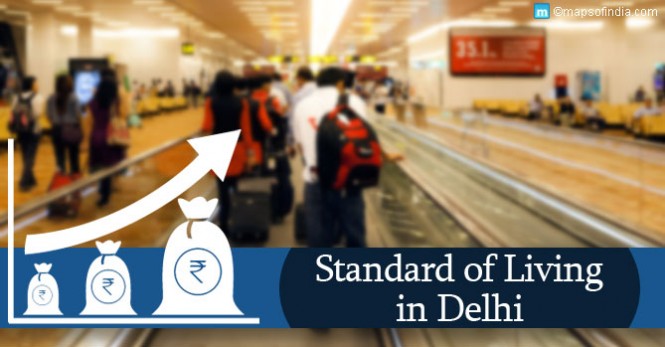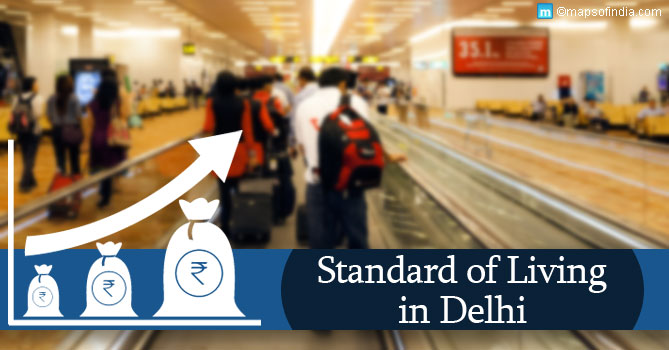 Rise in Delhi’s Per Capita Income
Rise in Delhi’s Per Capita Income
According to recent news reports, Delhi’s per capita income for the financial year 2014-15 went up from INR 2.12 lakh (recorded in the previous fiscal year) to about INR 2.41 lakh. This is a stupendous 13.6 per cent rise. These estimates come from the Economic Survey of Delhi 2014-15 that was presented to the Delhi Assembly in late June.
What is Per Capita Income?
Per capita income is also called income per person. It is the average of the income earned by all the people or the total population of a city or country. It is usually calculated by dividing the total income (in terms of GDP) by the population of the geographic unit.
The Economic Survey of Delhi is released each year by the Planning Department in an effort to capture the key economic parameters on which the capital region’s growth and government policies may be based. Of the data provided by this survey, the per capita income is one of the most important.
Delhi’s growth in per capita income comes as a surprise because of the vast gap between the income earned across the country and the income earned by those living in the capital region. According to current estimates, an individual living in Delhi earns about INR 2.41 lakh a year while the per capita income of the country as a whole is estimated at INR 88,533 (data from news reports). All the more surprising is that the national per capita of INR 88,533 (FY 2014-15) has been reached after a great deal of initiative taken by the government and governmental agencies. The national per capita registered a 37.6 per cent growth over the last four fiscal years taken together. In FY 2009-10, the per capita estimate for the capital region was pegged at a mere INR 1.2 lakh. Goa is, perhaps, the only other state with this level of prosperity. Goa’s per capita income for FY 2013-14 was estimated at INR 2.85 lakh.
Delhi’s Economic Profile
The Economic Survey of Delhi report says that the Gross State Domestic Product (GSDP) at current prices for FY 2014-15 shot up by about 15.35 per cent over FY 2015-16 to reach the INR 4.51 lakh crore mark. Growth in the GSDP for the year was estimated at 8.2 per cent. New Delhi is the commercial capital of North India, though a number of factories and businesses are relocated to the suburbs these days. According to a news report from 2014, New Delhi had about 1980 Ultra High Net Worth (UHNW) people – with an average wealth of INR 183 crore.
Delhi has a strong services sector, balanced by numerous manufacturing units dotting the state. Real estate is another major sector in the state. Delhi government reported a growth in tax collections by about 2.64 per cent in FY 2014-15 and a revenue surplus of about INR 6079.53 crore for the fiscal year.
People and Standard of Living
As a natural corollary to the high per capita income, standards of living in the capital region, too, are higher than most other parts of the nation. In Delhi, about 88 per cent of the 3.3 million households (including low income groups) own a television. This is quite above the national average (about 50 per cent households across the country own a TV). Similarly, almost 33 per cent households own a computer. Mobile proliferation, too, is among the highest in the national capital region. More than 90 per cent households in the state now own a telephone (including mobile phones).
It does look, though, that a high per capita income does not point to uniform distribution of wealth. 2014-15 estimates point at a total car ownership amounting to about 2.8 million. Estimating by the fact that these cars are owned by only 27 per cent households, one can guess that a number of households own multiple cars.
Along with high standards of living, though, comes a high cost of living. Mercer’s “Cost of Living Survey 2015” ranks New Delhi at number 132 among the world’s costliest cities. In India, it is second only to Mumbai. The capital region boasts of high quality healthcare and high literacy rates (86.2 per cent in 2014-15) as well.
Crime rates in the national capital region are perhaps highest in the nation. In 2014, crime rates in Delhi increased by about 99.22 per cent. A total of 1,47,230 crimes were registered in all. Crimes against women were at an all-time high with about 2,096 rape cases being registered last year. The capital records a high number of road traffic accidents and vehicle thefts each year.
According to a 2014 UN report, Delhi is the second most populous city in the world with a population of about 25 million. Each year, about 38.2 lakh immigrants pour into the city in search of better employment and better life.
Is Wealth a Trade-off in the Capital?
One of the more startling and deeply disturbing revelations that came from the Economic Survey of Delhi is the decline in environmental conditions in the city. Air pollution has been a major concern in the capital. Recently, an international journalist wrote a heartbreaking account of his decision to move away from Delhi (and India) on account of the health issues his children faced, brought on by Delhi’s air pollution. The Economic Survey seems to vindicate the view. The Particulate Matter levels in the capital’s outdoor air have risen quite sharply to 318 micrograms per cubic metre in 2014 from 282 micrograms per cubic metre in 2013. The Environment Protection Agency of the US sets the acceptable limit at 35 micrograms per cubic metre. Anything beyond this affects public health, says the agency. This does get us to wonder if increasing income in the capital region is merely a trade-off and are health and environment the real victims in Delhi.




